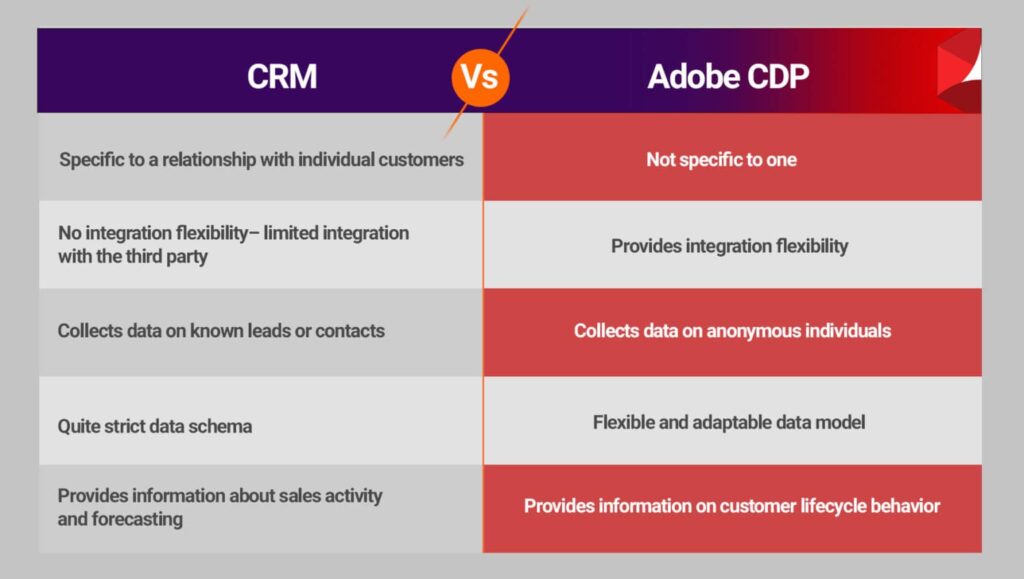
Customer Data Platform has shown promising features to deal with the challenges faced by Marketers. It gathers all your data in one place so that it can be accessed with ease by everyone for – Sales, marketing, and customer services. It breaks silos in the organization and presents a unified view of the customer data and profile that can be used by anyone not specific to sales or marketing or others. In a very brief period, it has made a significant place in today’s enterprise MarTech stack.
Adobe has introduced a Real-Time Customer Data platform (Real-Time CDP) with extensive capabilities. This new CDP technology solves the problems related to integration, labeling, segmentation, of customer data. Now, you can have in-depth information about your customers to build and execute an effective segmentation strategy based on integrated profiles.
Read how Adobe RT-CDP improves the customer journey.
Though there are many reasons, here we are presenting the 5 most powerful capabilities that could be a reason to migrate to Real-time Adobe CDP (RT-CDP).
Data Collection
With over 40 native connectors, 200+ partners, and more than 75 prebuilt marketing activation destinations, Adobe RT-CDP offers extensive capabilities for data collection. You can feed client-side information, server-side collection (APIs) data, call center data, mobile and app data, in-store data, and data from the CRM system into CDP. The incoming information can be behavioral data, demographic data, transactional data, POS, IoT, device data, and others. Apart from these, Adobe lets you build your own Connectors powered by APIs and get your data in.

Profile Management
The major challenge in delivering relevant digital experiences to the customers is the management of disconnected data and how to tie these data together coming from various channels. Adobe’s enterprise CDP helps in managing disconnected data, providing relevant and consistent digital experiences to your customers. It stitches data together to provide a complete view of your customers by linking identities and creating identity graphs for individuals. Adobe Real-Time CDP takes identity and profile management to a whole new level. It also offers streaming data ingestion that means profiles can be updated in real-time whenever any new action is noted.
No 3rd Party Cookies Dependency
Adobe prioritizes privacy and data governance in data collection and management. This is why it gives priority to first-party data. It stitches durable identifiers (e.g., email ID, contact details, CRM ID, etc.) with pseudonymous first-party cookie IDs. This will give you more control over data sharing and integration and insulate you from the problems that occur because of third-party data.
In Adobe CDP, identities take a different path by pegging them to the data sets. A data set can come in with any ID or multiple IDs and these IDs can be stitched together in real-time. Durable identifiers like email ID, phone number, CRM ID are stitched with pseudonymous first-party cookie IDs. Further, the data sharing and integrations are built on these synced IDs which help you get more control and insulate from 3rd-party data problems.
Let’s talk about what our Nextrow experts can do for
your business.
Adobe RT-CDP and CRM
Both are used to deepen customer relations but in different ways. They are different in the way how they are involved in marketing.

Closing Thoughts
Customer Data Platform is growing rapidly in the market and the reason is obvious. DMP and CRM have some equivalent features but overall CDP can stay on top with advanced features and capabilities. If you are confused about which vendor would be a perfect fit for you, see our guide.
For any query and help related to Adobe CDP integration and others, connect with us at marketing@nextrow.com.
Let’s talk about what our Nextrow experts can do for
your business.
Get In Touch
Driving business growth by transforming challenges into opportunities with innovative, tailored solutions that deliver measurable results.

